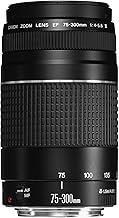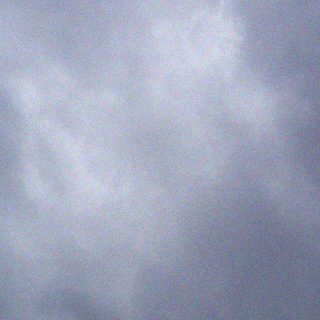Hummingbirds are some of the most fascinating creatures in nature. Their tiny size, vibrant colors, and rapid wingbeats make them a joy to watch. In Ohio, these beautiful birds are seasonal visitors, bringing life and energy to gardens and parks. This guide will help you learn about the hummingbird species found in Ohio, how to identify them, and tips for attracting them to your yard.
Common Hummingbird Species in Ohio
Ohio is home to a few hummingbird species, with one being the most common. Let’s explore these incredible birds and their unique traits.
Ruby-throated Hummingbird
The Ruby-throated Hummingbird is the most common species in Ohio. In fact, it’s the only hummingbird that breeds in the eastern United 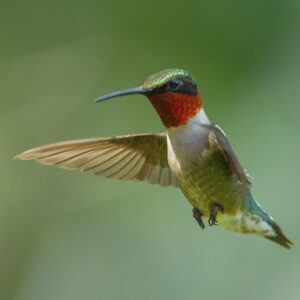 States.
States.
-
Appearance: Males have a brilliant red throat (called a gorget), while females have a plain white throat. Both sexes have green backs and white underparts.
-
Size: These birds are tiny, measuring about 3–4 inches long.
-
Habitat: They thrive in gardens, wooded areas, and near flowering plants.
-
Behavior: Ruby-throated Hummingbirds are known for their agility and speed. They can hover mid-air while feeding on nectar or catching insects.
-
Migration: These birds arrive in Ohio in late April and leave by early October. They migrate thousands of miles to Central America for the winter.
You’re most likely to see Ruby-throated Hummingbirds during the summer months when flowers are in full bloom.
Rufous Hummingbird
The Rufous Hummingbird is less common but occasionally visits Ohio during migration. This species is known for its fiery orange color and feisty 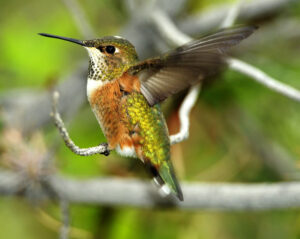 personality.
personality.
-
Appearance: Males are bright orange with an iridescent red throat, while females are greenish with some orange on their sides and tails.
-
Habitat: Rufous Hummingbirds prefer open areas like meadows or gardens with plenty of flowers.
-
Behavior: These birds are highly territorial and will chase away other hummingbirds from feeders or flowers.
-
Migration: Rufous Hummingbirds typically pass through Ohio during late fall or early winter, making them rare but exciting visitors.
If you spot a Rufous Hummingbird in Ohio, consider yourself lucky!
Other Rare Visitors
Ohio has documented several rare hummingbird sightings over the years, showcasing the state’s role as an occasional host for these extraordinary visitors. Below is an expanded overview of these sightings and the fascinating details surrounding them.
—
Allen’s Hummingbird: Ohio’s First Record
The Allen’s Hummingbird made its debut in Ohio in late 2009, marking a significant milestone for bird enthusiasts. This tiny hummingbird, 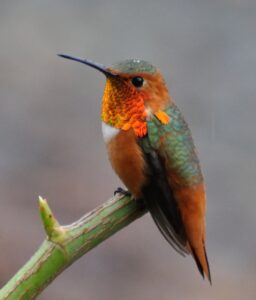 weighing only about 3 grams, was first spotted in Holmes County. The bird frequented a feeder at Mae Miller’s home, where it became a sensation among birders.
weighing only about 3 grams, was first spotted in Holmes County. The bird frequented a feeder at Mae Miller’s home, where it became a sensation among birders.
Identification: The bird was confirmed by Allen Chartier, a licensed hummingbird bander. He carefully measured its tail feathers and other features to distinguish it from the similar Rufous Hummingbird.
Behavior: The Allen’s Hummingbird regularly visited the feeder, even in frigid weather, making it easy for birders to observe.
Significance: Holmes County has produced many rare bird records due to its bird-friendly environment and active local birders.
This sighting was part of a broader trend of western hummingbirds appearing far east of their typical ranges, likely due to climate changes and increased use of feeders.
—
Calliope Hummingbird: A Tiny Marvel
The Calliope Hummingbird holds the title of North America’s smallest bird, weighing less than a ping-pong ball. Ohio has recorded two sightings 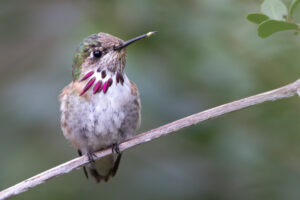 of this species: one in Chillicothe in 2002 and another in Delaware County in 2017.
of this species: one in Chillicothe in 2002 and another in Delaware County in 2017.
2002 Record: The first Calliope sighting occurred from October 28 to November 1 in Chillicothe. This hatch-year male was identified by expert Bryan Sharp based on photos shared by local birders.
2017 Record: The second sighting took place at Tania and Corey Perry’s home north of Columbus. Their hospitality allowed many birders to view this rarity as it perched near feeders or lilac bushes.
Behavior: Calliope Hummingbirds are tame and often perch for extended periods, making them easier to photograph and observe.
These sightings highlight how western hummingbirds occasionally stray eastward during migration.
—
Black-chinned Hummingbird: A Rare Banding Event
Ohio’s first Black-chinned Hummingbird was banded in November 2020 near Columbus by Allen Chartier. Initially mistaken for a Ruby-throated 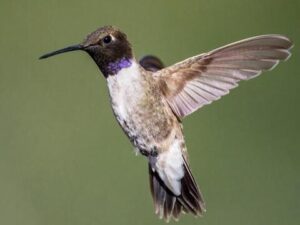 Hummingbird, this rare visitor’s identity was confirmed through careful measurements during banding.
Hummingbird, this rare visitor’s identity was confirmed through careful measurements during banding.
Identification Challenges: Black-chinned Hummingbirds are tricky to identify due to their similarity to Ruby-throated Hummingbirds, especially in subadult plumage.
Significance: This sighting added another notch to Ohio’s growing list of western hummingbird records.
Banding events like this provide invaluable data about migration patterns and species distribution.
—
Anna’s Hummingbird: Hardy and Expanding
Anna’s Hummingbird is known for its adaptability and expanding range across North America. Ohio recorded its third sighting in October 2024 in 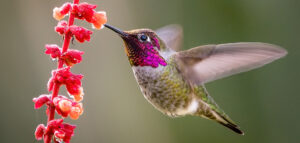 Columbus, where the bird stayed for over a week at Gerry and John Brevoort’s yard.
Columbus, where the bird stayed for over a week at Gerry and John Brevoort’s yard.
Range Expansion: Originally native to California, Anna’s Hummingbirds have expanded eastward due to widespread planting of nectar-rich flowers and increased use of feeders.
Behavior: These birds are hardy and can tolerate colder climates compared to other hummingbird species.
Significance: Anna’s Hummingbirds are now documented across nearly every U.S. state, showcasing their remarkable adaptability.
The Brevoorts’ hospitality allowed many visitors to enjoy this rare sighting while contributing observations to ongoing studies.
—
Rufous Hummingbird: Frequent Visitor
Among rare hummingbirds in Ohio, Rufous Hummingbirds are the most common vagrant species. Dozens of records exist annually as these birds 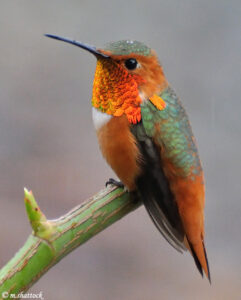 migrate eastward during fall or winter.
migrate eastward during fall or winter.
Identification: Rufous males are bright orange with iridescent red throats, while females have greenish backs with orange accents on their tails.
Migration Patterns: Rufous Hummingbirds have one of the longest migration routes of any hummingbird species, traveling from Alaska to Mexico.
Behavior: They are highly territorial and often chase other birds away from feeders.
Rufous sightings are exciting but less surprising compared to rarer species like Allen’s or Calliope.
—
Conservation Efforts and Implications
The increasing presence of western hummingbirds in Ohio reflects broader ecological changes:
1. Climate Change: Altered weather patterns may be shifting migration routes.
2. Human Influence: Feeders provide reliable food sources that encourage vagrant birds to linger.
3. Habitat Preservation: Mixed forests and gardens with native plants play a crucial role in supporting these visitors.
Birders and researchers continue documenting these rare sightings, contributing valuable insights into hummingbird behavior and migration trends.
—
Conclusion
Ohio’s documented sightings of rare hummingbirds demonstrate the state’s importance as a stopover for vagrant species during migration. From the tiny Calliope to the hardy Anna’s Hummingbird, each record adds depth to our understanding of these remarkable birds.
Whether you’re an avid birder or just curious about nature, keeping an eye on your feeders during fall or winter could lead to spotting one of these rare gems!
Best Practices for Photographing Hummingbirds in Ohio
Capturing photos of hummingbirds can be both challenging and rewarding. Their quick movements require patience and skill, but with the right techniques, you can take stunning pictures of these tiny birds.
Equipment Recommendations
First, having the right equipment makes all the difference when photographing hummingbirds:

-
Use aDSLR or mirrorlesscamera for high-quality images.
-
A telephoto lens(300mm or longer) helps you zoom in without disturbing the bird.

Canon EF 75-300mm telephoto-lens. -
Consider using a tripod to keep your camera steady.
-
A fast shutter speed (1/1000s or faster) freezes their rapid wingbeats.
Investing in good gear ensures you can capture every detail of these beautiful creatures.
8 EASY tips for improving your hummingbird photography. Hummingbirds can be some of the most interesting subjects to photograph… they can also be the most tricky. I share some simple tips that helped me when I was first starting off with photographing hummingbirds. I can’t wait for their return! Hope you enjoyed and happy birding!
Techniques for Capturing Stunning Shots
Next, let’s talk about techniques that work well when photographing hummingbirds:
-
Timing is key: Early morning or late afternoon provides soft lighting and active birds.
-
Attract them naturally: Place feeders or native plants near your photography spot.
-
Be patient: Stay still and quiet to avoid scaring them away.
-
Focus on their eyes: Sharp focus on their eyes makes your photos more engaging.
-
Experiment with angles: Try different perspectives to create unique compositions.
With practice and persistence, you’ll be able to capture breathtaking images of hummingbirds.
Welcome to my Hummingbird Photography Masterclass – Everything you need to know to take amazing Hummingbird pictures!
Set Ups For ANY Location + Hummingbirds: Everyday Bird Photography Hacks!
How to take photos of Hummingbirds. This week’s video is about Hummingbird and how to take their photo. Hummingbirds are common on most of the Americans and can easily be photograph. Here in North Carolina, we have one very common hummingbird the Ruby-throated Hummingbird. We also have a few others that pop in but if you see a hummingbird most likely it is a Ruby-throated Hummingbird. Photographing hummingbird can be very easily done. Setting up a hummingbird feeder is a get way to have hummingbird in your backyard. Also planting native flowering plants will attack hummingbird to your backyard to photography. I hope you enjoyed the video.
Photographing Hummingbird in your backyard, Part 2 This is part two of our two-part video about photographing hummingbird in your back yard. To see part 1, click here  • How to take photos of hummingbirds. P… Last week I talked about attracting hummingbird to your back yard. Today I will show you how to photograph them. I have always enjoyed photographing hummingbird. I just feel that they are one of the best birds to photograph. They way then moved and how fast they are. Thank you for watching
• How to take photos of hummingbirds. P… Last week I talked about attracting hummingbird to your back yard. Today I will show you how to photograph them. I have always enjoyed photographing hummingbird. I just feel that they are one of the best birds to photograph. They way then moved and how fast they are. Thank you for watching
Creating a Hummingbird-Friendly Garden in Ohio
If you want to attract more hummingbirds to your yard, creating a garden designed for them is essential.
Native Plants That Attract Hummingbirds
Hummingbirds rely on nectar-rich flowers for food. Planting native species ensures they have access to their favorite blooms throughout the season.
Here are some great options for Ohio gardens:
-
Bee Balm (Monarda): Vibrant red flowers that attract hummingbirds easily.
-
Cardinal Flower (Lobelia cardinalis): Tall spikes of red blooms perfect for mid-summer feeding.
-
Trumpet Vine (Campsis radicans): A climbing vine with tubular orange-red flowers.
-
Columbine (Aquilegia canadensis): Early spring blooms that provide food before other flowers emerge.
Planting these flowers in clusters creates an irresistible buffet for hummingbirds.
Here’s a complete guide to attracting hummingbirds to your yard. It lists plants, vines and shrubs that are in bloom for spring, summer and fall. Your hummingbirds will always have flowers to feed on.
Using Feeders to Attract Hummingbirds
In addition to flowers, feeders are an excellent way to attract hummingbirds.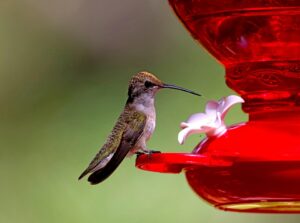
Here’s how to set up feeders successfully:
-
Choose feeders with red accents to catch their attention.
-
Fill them with homemade nectar (1 part sugar to 4 parts water). Avoid using red dye!
-
Clean feeders regularly to prevent mold or bacteria growth.
-
Place feeders near flowers or shaded areas where birds feel safe.
By combining feeders with native plants, you’ll create a haven for hummingbirds all season long.
Here’s a great article that tells everything you need to know about how to choose the best place to hang your hummingbird feeder.
Here’s the best designed hummingbird feeder to use. It’s leak proof, so it won’t attract insects and it’s easy to take apart and clean.
Here’s a comprehensive guide to help you clean your hummingbird feeder for those times when the nectar is not changed soon enough and mold starts to grow.
Conservation and Protecting Hummingbirds in Ohio
Hummingbirds face several threats that can impact their populations over time.
Threats to Hummingbird Populations
Unfortunately, habitat loss is one of the biggest challenges for hummingbirds today:
-
Urbanization reduces natural nesting sites.
-
Pesticides harm both insects (their protein source) and nectar-producing plants.
-
Climate change disrupts migration patterns by altering blooming times.
These factors make it harder for hummingbirds to survive and thrive.
How You Can Help Protect Them
Thankfully, there are simple ways you can help protect hummingbirds:
-
Plant native flowers that provide food throughout the year.
-
Avoid using pesticides or herbicides in your garden.
-
Participate in citizen science projects like tracking migration data.
-
Advocate for preserving natural habitats across Ohio.
Every small action contributes toward protecting these amazing birds for future generations.
Frequently Asked Questions About Hummingbirds in Ohio
Here are answers to some common questions about hummingbirds in Ohio:
When is the best time to see hummingbirds in Ohio?
The best time is between late April and early October when Ruby-throated Hummingbirds migrate through the state.
How do I tell male and female Ruby-throated Hummingbirds apart?
Males have a bright red throat (gorget), while females have a plain white throat with no red coloration.

Do any hummingbirds stay in Ohio year-round?
No species stay year-round; all migrate south during winter months.
Can I use store-bought nectar instead of homemade?
Homemade nectar (sugar water) is better because it’s free from additives like dyes or preservatives found in store-bought options.
Conclusion
Hummingbirds bring beauty and wonder wherever they go—and Ohio is no exception! By learning about their habits, planting native flowers, and providing safe feeding spaces, you can enjoy these incredible birds right from your backyard.
So why not start today? Create your own hummingbird-friendly garden or grab your camera for some amazing shots! Share your experiences with friends or online communities—it’s always exciting to connect over nature’s wonders.
Let’s work together to protect these tiny treasures so they continue enchanting us year after year!
One of the best Hummingbird feeders that’s easy to take apart and clean is the HummZinger Ultra.
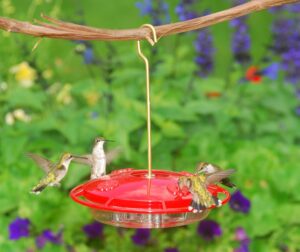
Aspects 12oz HummZinger Ultra With Nectar Guard.
The HummZinger Ultra 12oz Saucer Feeder is one of the best options for a hummingbird feeder that’s both easy to clean and maintain. This top-tier feeder features patented Nectar Guard tips—flexible membranes on the feeding ports that keep flying insects out while still allowing hummingbirds to feed freely. Plus, it comes with an integrated ant moat to prevent crawling insects from reaching the nectar, and the raised flower ports help divert rain, keeping the nectar fresh.
With a 12 oz capacity, this mid-size feeder offers plenty of space and can be hung or mounted on a post using the included hardware. It has four feeding ports and is made from durable, unbreakable polycarbonate. Whether you’re concerned about bees, wasps, or ants, this feeder is built for easy cleaning and insect protection.
If you already have a hummingbird feeder, and you want to protect it from ants and other crawling insects, the ant moat below will do the job.
Trap-It Ant Moat for Hummingbird Feeders
Using an ant moat for your hummingbird feeder is an effective way to keep ants away from the sweet nectar. These tiny creatures are drawn to
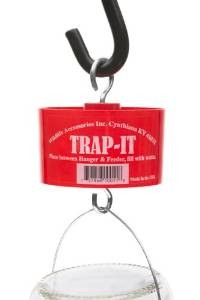
the sugar water, and without a barrier, they will quickly infest your feeder, preventing the birds from enjoying the nectar. An ant moat works by creating a barrier of water that ants can’t cross. Positioned above the feeder, it effectively blocks the ants’ path, keeping them from reaching the nectar.
This simple solution also ensures that your hummingbird feeder remains clean and accessible for the birds, rather than becoming a breeding ground for ants or other pests. It’s a small addition that can make a big difference in maintaining a healthy, inviting space for hummingbirds, while also reducing the need for chemical ant deterrents.
The first and still the best to protect your Hummingbird and Oriole feeder from ants and other crawling insects. Insert between hanger and feeder and fill with water, providing a barrier to crawling pests. Red color to attract hummingbirds.
| Small bottle brushes and pipe cleaners are always helpful to dislodge mold inside the feeder and in the feeding ports. It is necessary to have a clean mold free feeder to attract hummingbirds and to keep them healthy. |
If you found this article helpful please share it with your friends using the social bookmarking buttons on the left side of this page. Help everyone to increase their enjoyment of feeding hummingbirds. Do it for the hummingbirds!
Hummingbird Resources
U.S. Fish and Wildlife Service – Hummingbird Conservation
This site offers detailed information about various hummingbird species, their habitats, and conservation efforts. It also provides resources on how to protect these fascinating birds.
National Park Service – Hummingbird Resources
The National Park Service offers insights into hummingbird species found in national parks, their behaviors, and their role in ecosystems, along with tips for observing them.
Smithsonian National Museum of Natural History – Birds: Hummingbirds
This resource provides educational materials on the role of hummingbirds in pollination and biodiversity, backed by scientific research and exhibits from the Smithsonian.
